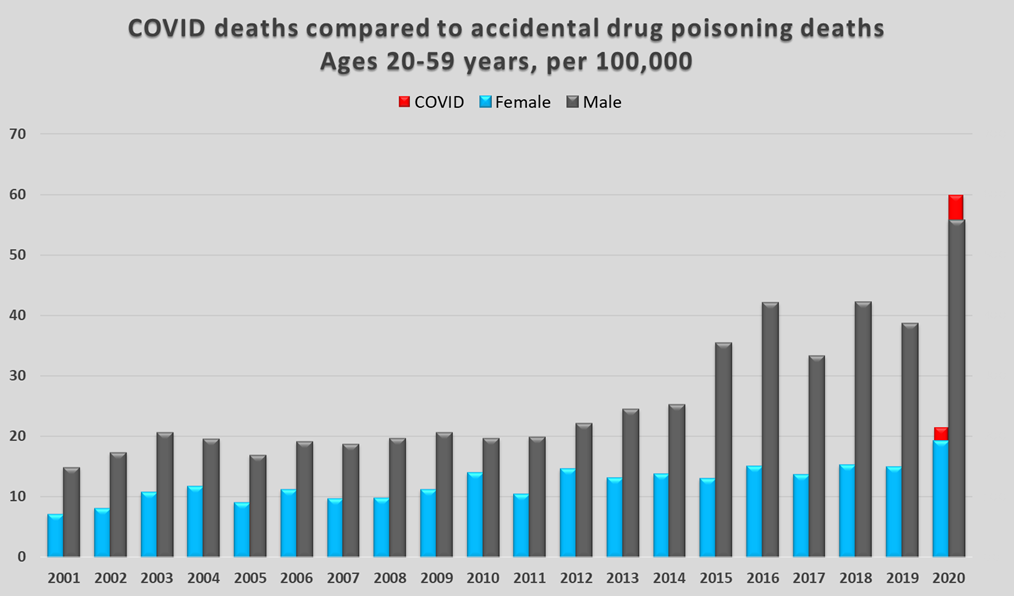Am I a bad person for getting excited by the discovery that the 2020 data was available in the Alberta Death database? I was anxious to dive into the information that could put that strange year in context, and perhaps shed some light on what to expect going forward. Mixed messaging, alarming on all sides, had been propagated throughout 2020 by all types of media; headlines and commentators gravely reporting the latest cluster of COVID deaths, or warning of the escalation in suicides or drug overdoses blamed on mental breakdowns caused by excessive lockdowns. It seemed there was nothing but grim news and dire prospects. Looking back, what does the real data tell us about the validity of these disturbing reports?
In a previous article on BIG Media, Assessing the relative lethality of COVID-19: a Canadian case study, we compared deaths and death rates from various causes between 2003 and 2019 using the numbers reported by the Alberta government for COVID deaths. This article updates that analysis with the addition of deaths from all causes in 2020.
The first thing to note is that COVID deaths have been tabulated in two databases, the Alberta Health Database[1] and the Alberta Death database.[2] These databases do not agree with each other. The total number of deaths attributed to COVID in 2020 in the death database is 1,112, 28% lower than the 1,535 reported in the health database (the source quoted frequently in the media).
While we do not have an official explanation for this discrepancy, the health database does not explicitly state that COVID was the cause of death. There is simply an inventory of COVID cases and outcomes. Perhaps a “died” outcome in this ledger does not necessarily mean that COVID was the cause. Subsequent review by the medical examiner may have assigned a different cause when the death was officially recorded in the death database.
Using the COVID deaths from the presumably audited death database, we can now put the mortality of COVID into perspective with all other deaths in 2020, and relative to previous years. Figure 1 shows deaths from 2003 to 2020 of all causes classified by gender and age group (per 100,000 of population). The additional contribution from COVID is shown as a red increment to the 2020 bars.
Figure 1: All causes of death in Alberta, by year, gender, and age (tabs). Deaths attributed to COVID-19 are shown in red.
As expected, the largest influence from COVID is in the older age groups, helping boost deaths per 100,000 in 2020 in the over-70s to levels higher than 2019, despite a decreasing trend overall (more pronounced in men). A more troubling observation is that in all other age groups 10 and older, COVID as a cause of death was statistically insignificant, but the death rate increased over 2019 anyway. In fact, for men age 20-59, and women age 10-49, the 2020 death rate was the highest or close to the highest since 2003. What are the reasons for this?
We will start a deeper analysis of these trends with the charts in Figure 2, which shows the top 10 causes of death in 2020 for each age group and gender.
Figure 2: Top 10 causes of death in 2020 (per 100,000); top, females; bottom, males.
From age 10 to 49, for both genders, accidental deaths are in the top 3. Suicide rates are also significant in this age group — more so for men than women. An uncomfortable number of deaths are from unknown causes, and these “unknowns” consistently place in the top 5 in all age groups below 70 (more about that later). The big, dependable ones – cancer, heart disease, lung disease, and brain disease – remain significant killers in 2020. Aside from a sliver in the 20-29 year old female group, COVID does not make the top 10 until the 60-69-year age group for both men and women.
Putting these deaths in perspective by looking at a selection of the biggest overall contributors – cancer, heart disease, brain disease, accidents, suicide, and unknown – plus COVID, we can visualize trends over the past 19 years. (Figure 3)
Figure 3: Top six overall killers, plus COVID-19, by year and age (tabs). Top, per 100,000 females. Bottom, per 100,000 males.
That “unknown” category really stands out in these charts. This is not, however, unique to 2020. In 2017, 2018, and, to a lesser extent, in 2019, there was also a significant increase in unknown deaths in primarily the younger age groups, over the average of the previous 14 years. Your BIG Media correspondent made inquiries to the Alberta Office of the Medical Examiner to try to understand the context of this category. I learned that “unknown” is a bucket within which, typically, unnatural deaths (suicide, accidents, and homicides) are placed until they can be further investigated. These are therefore re-categorized over time as those investigations are completed. So, what looks like an increase of unknown causes of death in the past few years is, in reality, a backlog of cases requiring investigation.
Suicide rates in 2020 are not significantly different from typical past levels in any age group or gender. Deaths by accidental causes, however, have increased in the 20-49 age range for both genders. Keep in mind that a portion of the unknown deaths awaiting categorization will increase the number of unnatural deaths, of which suicide and accidents comprise the largest categories. Consequently, the numbers in those groups are likely conservative.
Accidental death is always tragic, but there are specific categories worth investigating further in the pandemic context. Death by accidental drug poisoning, in particular, could represent drug overdoses.
In the prime, active, child-rearing, productive, working years from 20 to 59, COVID was not a significant killer, contributing 2.3 and 4.2 deaths per 100,000 females and males, respectively. However, accidental deaths due to drug poisonings in the same age range were responsible for 19.2 per 100,000 women and 55.7 per 100,000 men, representing a 27% (females) and a 44% (males) increase over 2019. (Figure 4) The trend of male drug poisoning deaths had been increasing over the previous few years. Even taking that into account, 2020 was statistically worse. While we may never know with certainty the cause of the increases, this age group was likely the most affected by the economic and lifestyle consequences of measures taken to mitigate the spread of COVID.
Even as lockdowns and restrictions no doubt saved some lives that might have been taken by COVID, did they also create conditions that exacerbated the severity of another killer in a different vulnerable segment of society?

Figure 4: Accidental drug poisoning deaths from age 20-59, per 100,000, by year and gender. COVID-19 deaths shown in red for comparison.
If measures were not taken to mitigate the spread of COVID, what would these charts look like? Notwithstanding the uncertainty remaining in the “unknown” category, deaths would almost certainly be distributed differently across age groups and causes. Would the result have been “better” by some sort of unemotional accounting?
What other consequences might have resulted – for example, secondary health issues that may have occurred if the health system had been overloaded as it was in Italy and New York in the early days of the pandemic? Knowing what we know now, would we have done anything differently? Did our leaders make the best possible decisions at the time in the context of limited data and significant future uncertainty? Have we learned how to identify and focus the most effective measures – with the least collateral damage – when the next pandemic (or variant) comes along? I hope so.
Death gets us all in the end. In the meantime, take care of yourself, and make the best of the years you have.
[1] https://www.alberta.ca/stats/covid-19-alberta-statistics accessed January 23, 2022
[2] https://open.alberta.ca/opendata/deaths-cause-by-gender-and-age, accessed January 2, 2022
(Laurie Weston – BIG Media Ltd., 2022)


